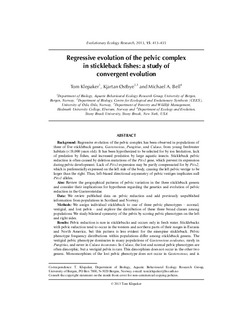Regressive evolution of the pelvic complex in stickleback fishes: a study of convergent evolution
Journal article, Peer reviewed
Permanent lenke
http://hdl.handle.net/11250/134652Utgivelsesdato
2013Metadata
Vis full innførselSamlinger
Originalversjon
Klepaker, T. O., Østbye, K., & Bell, M. A. (2013). Regressive evolution of the pelvic complex in stickleback fishes: a study of convergent evolution. Evolutionary Ecology Research, 15(4), 413-435.Sammendrag
Background: Regressive evolution of the pelvic complex has been observed in populations of
three of five stickleback genera, Gasterosteus, Pungitius, and Culaea, from young freshwater
habitats (<18,000 years old). It has been hypothesized to be selected for by ion limitation, lack
of predation by fishes, and increased predation by large aquatic insects. Stickleback pelvic
reduction is often caused by deletion mutations of the Pitx1 gene, which prevent its expression
during pelvic development. Lack of Pitx1 expression may be partly compensated for by Pitx2,
which is preferentially expressed on the left side of the body, causing the left pelvic vestige to be
larger than the right. Thus, left-biased directional asymmetry of pelvic vestiges implicates null
Pitx1 alleles.
Aim: Review the geographical patterns of pelvic variation in the three stickleback genera
and consider their implications for hypotheses regarding the genetics and evolution of pelvic
reduction in the Gasterosteidae.
Data: We review published data on pelvic reduction and add previously unpublished
information from populations in Scotland and Norway.
Methods: We assign individual stickleback to one of three pelvic phenotypes – normal,
vestigial, and lost pelvis – and explore the distribution of these three broad classes among
populations. We study bilateral symmetry of the pelvis by scoring pelvic phenotypes on the left
and right sides.
Results: Pelvic reduction is rare in sticklebacks and occurs only in fresh water. Sticklebacks
with pelvic reduction tend to occur in the western and northern parts of their ranges in Eurasia
and North America, but this pattern is less evident for the ninespine stickleback. Pelvic
phenotype frequency distributions within populations differ among stickleback genera. The
vestigial pelvic phenotype dominates in many populations of Gasterosteus aculeatus, rarely in
Pungitius, and never in Culaea inconstans. In Culaea, the lost and normal pelvic phenotypes are
often dimorphic, but a vestigial pelvis is rare. This dimorphism does not occur in the other two
genera. Monomorphism of the lost pelvic phenotype does not occur in Gasterosteus, and is rare in the other two genera. Asymmetry of pelvic vestiges is common in all three genera,
but left-larger directional asymmetry predominates only in Gasterosteus. This bias could be
due to the suggested regulatory mutation in the Pitx1 gene and/or mutations in downstream
targets of Pitx1, and suggests involvement of other genes for pelvic reduction in the other
genera.
